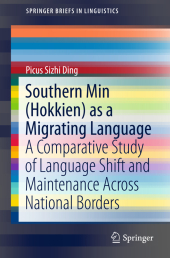 Neuerscheinungen 2015Stand: 2020-02-01 |
Schnellsuche
ISBN/Stichwort/Autor
|
Herderstraße 10
10625 Berlin
Tel.: 030 315 714 16
Fax 030 315 714 14
info@buchspektrum.de |

Picus Sizhi Ding
Southern Min (Hokkien) as a Migrating Language
A Comparative Study of Language Shift and Maintenance Across National Borders
1st ed. 2015. xiv, 109 S. 20 Farbabb. 155 x 235 mm
Verlag/Jahr: SPRINGER, BERLIN; SPRINGER SINGAPORE; SPRINGER 2015
ISBN: 981287593X (981287593X)
Neue ISBN: 978-9812875938 (9789812875938)
Preis und Lieferzeit: Bitte klicken
This book presents multilingualism as a social phenomenon, which arises when speakers of a different language move to a new society and learn to speak the dominant language of the society. It offers case studies of Hokkien migrating families when they encounter new languages in Burma, Macao and San Francisco, showing how a family changes across generations from monolingual to bilingual/multilingual and back to monolingual. In the process language shift occurs as a result of transitional bilingualism. The dynamic status of Hokkien is also attested at the societal level in Singapore, Taiwan and south Fujian, the homeland of Hokkien.
1. Introduction.- 2. Multilingualism in drifting families.- 2.1 The overall migration history of a Hokkien family.- 2.2 The first generation: from Hokkien to Burma.- 2.3 Case I in the second generation: from Burma to Macao.- 2.4 Case II in the second generation: from Burma to U.S.A.- 2.5 Case III in the second generation: from Burma to Macao.- 2.6 Multilingualism and bilingualism in the families.- 2.7 Hokkien as a legacy of the drifting families.- 3. The rise and fall of Hokkien in Singapore.- 3.1 The glorious days of Hokkien in Singapore.- 3.2 Effects of language policy: the Speak Mandarin Campaign.- 3.3 Bilingualism in the new generation of Hokkien Singaporeans.- 3.4 The current status of Hokkien in Singapore.- 4. Taiwan: the haven for Hokkien?.- 4.1 The spread of Hokkien from Fujian to Taiwan.- 4.2 Loss of dominant status to Japanese and Mandarin.- 4.3 Language revitalization in Taiwan: reconstructing multilingualism.- 4.4 The future of Hokkien in Taiwan.- 5. The fate of Hokkien in its homeland.- 5.1 The status of Hokkien since 1949.- 5.2 Promotion of Mandarin in mainland China.- 5.3 Hokkien as an endangered topolect under transitional bilingualism.- 6. Conclusion_.


